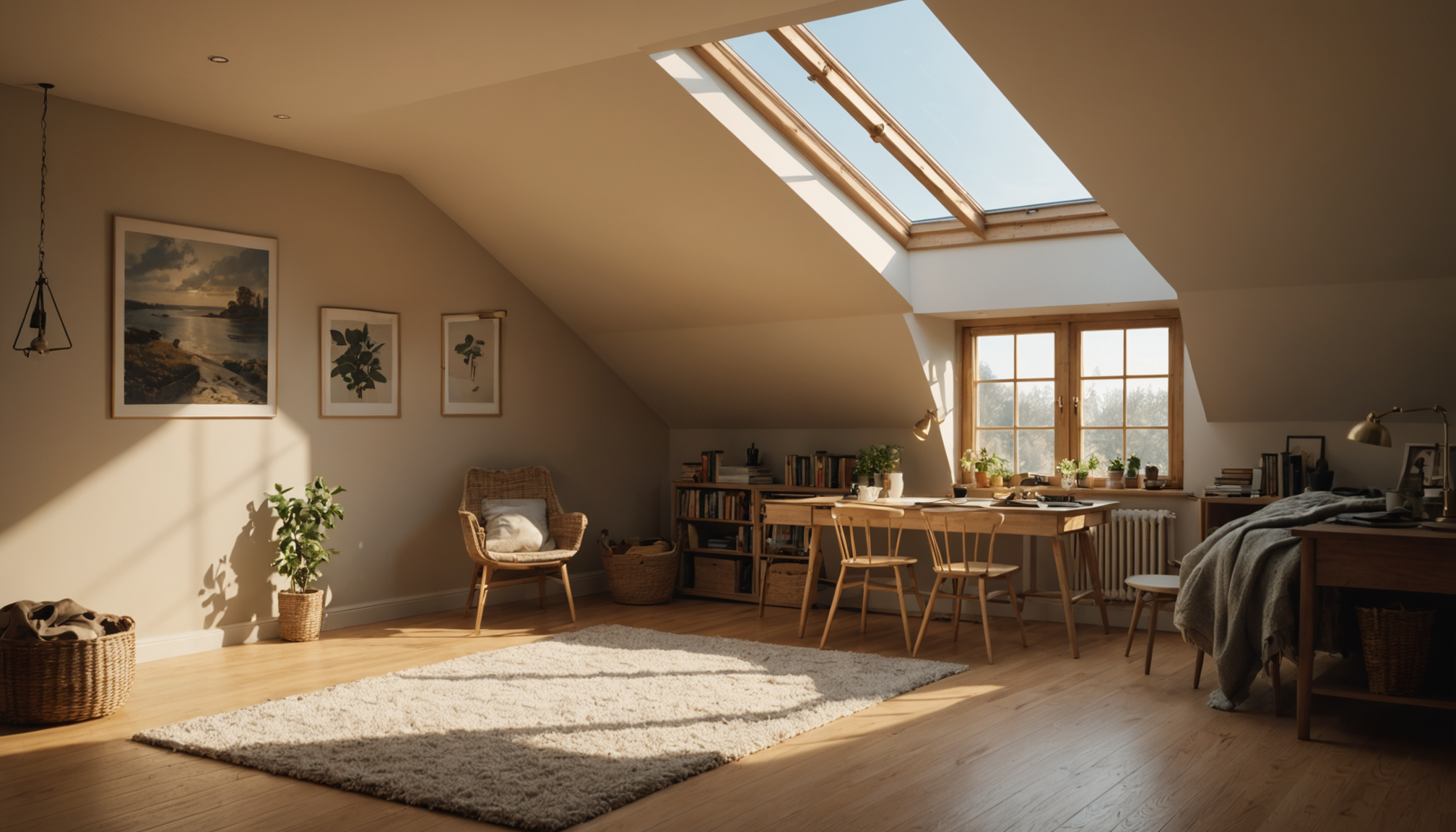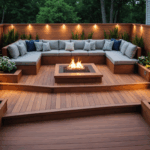Skylights can transform the ambiance of a home by introducing an abundance of natural light, enhancing aesthetics, and even cutting energy costs when integrated strategically. When considering skylight installation, it’s important to understand the different types available, each offering unique advantages and suited for specific architectural needs and personal preferences.
There are several types of skylights to consider:
- Fixed Skylights: These are non-operable skylights primarily installed to provide extra light. Ideal for areas in the home where ventilation is not a priority, fixed skylights are a cost-effective way to brighten spaces like attics or hallways.
- Ventilated Skylights: Ventilated or operable skylights can be opened, providing both light and air. They are perfect for rooms that require additional ventilation, such as kitchens and bathrooms, contributing to improved indoor air quality.
- Roof Windows: Larger and typically installed within reach, roof windows can be opened and are common in loft conversions to maximize views and daylight.
- Tubular Skylights: These are smaller, tube-like skylights that channel natural light from the roof to rooms without direct roof access. They are particularly popular in rooms like closets or hallways, where traditional skylights cannot be installed.
- Custom Skylights: For those with specific design visions, custom skylights allow for unique shapes and sizes tailored to the architectural nuances of a home.
Occupying a unique niche between traditional windows and ceiling lights, each type of skylight not only serves a specific purpose but also offers different aesthetic and functional benefits. The choice of skylight impacts both the installation process and potential cost implications significantly. Homeowners should evaluate the specific needs of their home, considering factors such as room placement, climate, ceiling height, and desired natural light intensity.
| Type of Skylight | Benefits | Best Suited For |
| Fixed | Cost-effective, great for added light | Hallways, attics |
| Ventilated | Allows fresh air circulation | Kitchens, bathrooms |
| Roof Windows | Opens for maximum light and view | Lofts, attics |
| Tubular | Efficient light channeling, small spaces | Closets, small and enclosed rooms |
| Custom | Tailored to specific design needs | Architectural designs |
Selecting the right skylight type is a critical step toward ensuring the desired quality and quantity of natural light in the home, alongside consideration for practical aspects such as installation ease and future maintenance. Being informed about these options enables homeowners to make choices that complement both their design aspirations and functional needs.
Materials and quality considerations
When selecting a skylight, understanding the materials used in its construction is paramount to ensuring both durability and performance. The choice of materials often influences the cost, energy efficiency, and longevity of the installation. Here is a breakdown of key material considerations for skylights:
1. Glazing Options:
– Glass Glazing: This is a popular choice due to its clarity and resistance to weathering. Glass glazing can be further categorized into tempered and laminated glass, each offering specific benefits.
– Tempered Glass: Known for its strength, tempered glass is about four times stronger than regular glass and shatters into less dangerous, small pieces when broken.
– Laminated Glass: Consists of two layers of glass with a plastic interlayer, which prevents shattering and enhances security, sound isolation, and UV protection.
– Plastic Glazing (Acrylic or Polycarbonate): While less expensive, plastic glazing options tend to be less durable and may become discolored over time due to UV exposure.
– Acrylic: Offers better clarity and is less prone to yellowing compared to polycarbonate, although it is not as strong in impact resistance.
– Polycarbonate: Provides excellent impact resistance and can withstand extreme weather but may yellow more over time.
2. Framing Materials:
– Wood Frames: Known for their natural insulation properties and appealing aesthetics. However, wood frames require more maintenance to protect against moisture and rot, which may increase long-term costs.
– Metal Frames (Aluminum, Steel): These frames are sturdy and offer high resistance to weather conditions. Aluminum, in particular, is lightweight, resistant to corrosion, and requires minimal maintenance. Steel frames, while stronger, tend to be heavier and may require additional support structures during installation.
– Vinyl Frames: Popular for their robust insulation capabilities and low maintenance requirements. Vinyl does not need painting or touch-ups and performs well in moisture-rich environments.
3. Coatings and Treatments:
– Consider coatings that enhance energy efficiency, such as low-emissivity (Low-E) coatings. These coatings help to reduce heat transfer, keeping homes cooler in summer and warmer in winter.
– UV-reflective coatings protect against fading of interior furnishings and are crucial for reducing exposure to ultraviolet light, an important consideration for preserving the longevity of both the skylight and the items inside the home.
4. Quality Ratings:
– Check for quality ratings like those from the National Fenestration Rating Council (NFRC), which provide standardized evaluations of energy performance.
– Skylights certified by Energy Star have met specific energy efficiency criteria, which can lead to significant savings on heating and cooling costs for the home.
Investing in quality materials is essential not only for the performance and durability of the skylight but also for maximizing potential savings on energy costs over time. As materials play a critical role in the skylight’s operation and aesthetic appeal, selecting high-quality options is a wise decision that balances initial costs with long-term benefits.
Installation process and labor costs
When planning the addition of a skylight, understanding the nuances of the installation process and associated labor costs is crucial to ensuring a smooth and successful project. Proper installation is not only integral to the skylight’s performance but also to the prevention of potential issues like leaks or structural damage to the home. Typically, skylight installation is a job best handled by experienced professionals due to the complexity and precision it demands.
The installation process starts with a thorough assessment of the roof structure. This is vital, as it helps determine the best location for the skylight, considering both functionality and aesthetic appeal. During this phase, contractors check for any structural reinforcements that might be needed to support the skylight, particularly with large or custom designs. Proper structural support is essential to prevent roof sagging or damage over time.
Once the best location has been identified and the roof assessed, the next step involves cutting an opening. This part of the installation requires meticulous care to ensure the opening is perfectly shaped to fit the skylight, minimizing gaps that could lead to energy loss or moisture penetration. The surrounding areas are usually reinforced with headers to maintain the roof’s integrity.
Following the opening preparation, the skylight unit is carefully positioned and sealed into place. High-quality flashing and sealants are crucial at this stage to secure a watertight and airtight bond, preventing leaks and maintaining energy efficiency. The flashing materials used here are designed to integrate seamlessly with roofing materials, which is particularly vital in areas prone to heavy rain or snow.
Labor costs for installing a skylight can vary significantly depending on several factors. These include the type of skylight being installed, the complexity of the roof design, and regional labor rates. For instance, tubular skylights generally involve lower labor costs compared to larger, more complex installations like custom or expansive roof windows. Additionally, homes with steep or difficult-to-access roofs might incur higher costs due to the increased effort and safety precautions required.
While labor costs can be a considerable part of the installation budget, investing in skilled labor is essential for ensuring quality and longevity. A well-installed skylight not only enhances the natural light and beauty of a home but also adds value, improves energy efficiency, and reduces heating and cooling costs over time. Engaging professionals who provide detailed quotes and warranties on their work offers peace of mind and protects your investment.
Overall, despite the potential for significant labor costs, the benefits of professional installation and the enhanced functionality and aesthetic appeal of your home make it a worthy investment. By choosing experienced installers who understand the intricacies of skylight placement and sealing, homeowners can enjoy the myriad benefits a skylight offers without the worry of post-installation issues.
Energy efficiency and savings
Maximizing energy efficiency is one of the most compelling reasons to install skylights in a home. When properly selected and installed, skylights can contribute significantly to a home’s thermal regulation, reducing the reliance on artificial lighting and cutting down on energy costs. Strategically positioned skylights allow for the capture of natural light, which not only brightens the interior spaces but also provides a renewable source of energy for warmth during the winter months.
One of the key aspects of a skylight’s energy efficiency is its ability to reduce heating needs during colder seasons. By allowing sunlight to enter, skylights can act as passive solar heating systems. This can be particularly advantageous in rooms with large expanses of ceiling space where the additional heat can circulate and offer substantial warmth. In fact, this natural heating can offset the need for electric or gas heating, leading to notable cost savings on energy bills. To fully exploit these benefits, it’s crucial to consider the skylight’s placement in relation to the sun’s path and seasonal changes.
Moreover, skylights fitted with energy-efficient glass can mitigate heat loss. Low-emissivity (Low-E) coatings on skylight glazing are especially effective. These coatings reflect heat back into the home during colder months while reducing heat ingress during warmer periods, thereby maintaining a comfortable indoor climate without overburdening air conditioning systems. Additionally, insulation around the skylight and proper sealing also play pivotal roles in preserving energy efficiency by preventing drafts and heat leaks.
In warmer climates, or for those concerned about excessive heat gain, the integration of blinds or shades with skylights can provide additional control. These can be manual or electrically operated and are essential for minimizing cooling costs during the summer. Some modern skylight models even come with smart technology that allows homeowners to automate the opening, closing, and shading based on temperature and sunlight levels.
Apart from direct energy savings, skylights can improve a home’s indoor living environment by contributing to better indoor air quality and reducing the growth of mold and mildew caused by damp conditions. For example, ventilated skylights serve the dual purpose of lighting as well as enhancing ventilation. This not only assists in maintaining optimal humidity levels but also in expelling heated air during the summer, thereby lowering air conditioning demands and associated costs.
Ultimately, while skylights present an initial investment, their long-term benefits in terms of energy savings are considerable. Homeowners can enjoy reduced utility bills and a more sustainable living environment. For those who need assistance in selecting and installing the most energy-efficient skylights, visiting LocallyFind.com can be invaluable. This home services directory connects homeowners with trusted local professionals who can provide expert advice and installation services tailored to specific home needs and climatic conditions. Take advantage of these resources to ensure that your skylight installation not only complements your home’s aesthetics but also enhances its energy efficiency and comfort.
Maintenance and warranties
Regular maintenance is essential for ensuring the optimal performance and longevity of skylights. Like any architectural feature, skylights are exposed to the elements, making them susceptible to issues such as leaks, condensation, and wear over time. By establishing a routine maintenance schedule, homeowners can address minor problems before they escalate, thereby extending the life of their skylights and protecting their home investment.
One of the fundamental maintenance tasks involves inspecting and cleaning the skylight’s glazing. Regular cleaning helps maintain clarity and allows maximum natural light to filter through. It is crucial to use non-abrasive cleaners and tools that won’t scratch or damage the skylight surface. Additionally, inspecting the seals around the skylight is vital for spotting signs of wear or degradation, which can lead to leaks if left unchecked. Re-sealing or applying fresh waterproof flashing when necessary ensures a robust barrier against moisture intrusion.
Inspecting the surrounding roofing materials is equally important, as any damage or shingling gaps near the skylight could compromise its integrity and cause leaks. Scheduling roof inspections, particularly after severe weather, can catch these potential issues early. Moreover, ensuring that gutters and roof drains are clear of debris helps prevent water buildup that might flood the skylight area.
Warranties offer homeowners peace of mind by providing protection against defects in materials or workmanship. Most reputable skylight manufacturers provide warranties that cover a specific period, during which repairs or replacements may be covered if a failure occurs. It’s essential to understand the terms of the warranty fully, including any actions that might void the coverage, such as unauthorized modifications or improper maintenance.
For installations by professionals, labor warranties may also be offered, guaranteeing the quality of the installation process itself. These warranties are particularly beneficial, as they ensure that any installation-related issues are promptly rectified. Retaining records of all maintenance work, inspections, and communication with manufacturers is advisable. This documentation can expedite any warranty claims and provide proof of proper care in the event of disputes.
Overall, by proactively managing maintenance and understanding warranty terms, homeowners can protect their skylight investment, enjoy consistent performance, and relish the natural light they bring into the home. Taking these steps not only enhances the beauty and functionality of the living space but also safeguards against unexpected expenses, ensuring the lasting value and enjoyment of skylight installations.
In conclusion, skylights can transform a home by enhancing aesthetics, providing natural light, and improving energy efficiency. However, careful consideration of factors such as type, materials, installation process, energy efficiency, and maintenance is crucial to maximizing the benefits and minimizing the costs. By making informed choices and working with experienced professionals, homeowners can enjoy the many advantages skylights offer while ensuring durability and value for years to come.


